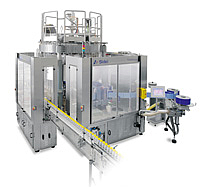Sidel Group launches the new Rollsleeve. The Rollsleeve machine is an innovative rotary labelerthat creates and applies plastic shrink sleeves from a machine direction orientation (MDO) label rollonto glass, plastic and metal containers. The Rollsleeve combines the simplicity of its consolidatedroll-fed group, resulting in highly customized container labeling, with the advantage of label filmcost reduction.
A new machine to support label trend
| According to figures announced in the AWA Labeling and Product Decoration Markets GlobalReview 2010, the market for heat shrink labels is growing fast (+4.4% in 2009) and at a muchhigher rate than other types of labels. The trend is particularly strong in rapidly industrializingcountries (South America, China and India). Launching the new Rollsleeve, the Sidel Group aims tomeet these fast growing market requirements. A unique solution in the market due to thecombination of four advantages that are particularly important for the customer and rarely found ina single solution: savings in costs, flexibility, quality and sustainability. |
Save costs thanks to the MDO label
A significant aspect, giving Rollsleeve an edge on more traditional sleeving systems, is the fact that the “tubing” takes place in the machine and ready made sleeves do not need to be outsourced. Rollsleeve tube creation process uses a MDO film (Machine Direction Orientation): this means that the film is stretched in the same direction of the machine.
As a result, the converting phase is lessened by two manufacturing steps: the forming and welding of the sleeves are now unnecessary. This system brings savings in the cost of label material up to 30%, compared to a traditional sleeve (TDO – Transversal Direction Orientation). Sidel Group estimates that with a throughput of 200 million bottles per year savings on the costs of label material alone mean that the entire initial investment will be recovered in 18 months.
Two machines in one which guarantees flexibility |
|
Very thin labels for sustainability and cost optimization
|
|
It can apply labels that are 50% thinner compared to a traditional sleever (that hardly allows thickness less than 50 microns) with thickness ranging from 18 to 150 microns (the latter is used when isolation from heat is required).
Heat & cool sealing: quality of labeling up to 54,000 bph
The special feature of this machine is shrink sleeve creation and application by a lengthways reel,thus ensuring that the labels are closed with no need for glues or solvents. As a result of the “heat &cool” sealing system, Sidel guarantees an excellent result. Since the sealing area can be positionedexactly to the edge of the label, the final overlap has no visual or tactile flaws after shrinkage. Thequality of labeling is optimal even with high speeds (up to 54,000 bph) and doesn’t depend on theheight of the container (the tube label is not lowered from above as in traditional technology).
| Sylvie RAK Tel.: +33 2 32 85 82 46 sylvie.rak@sidel.com |






